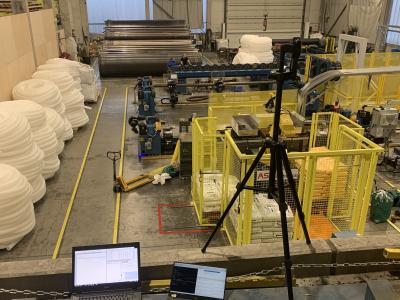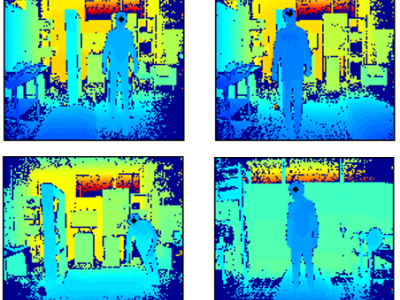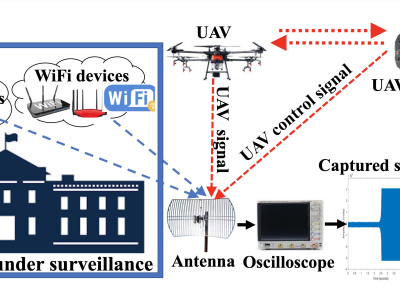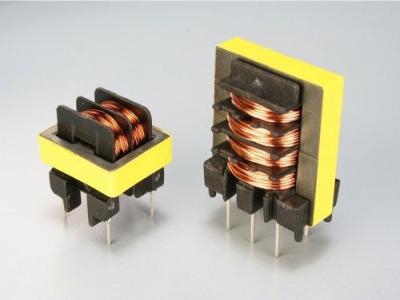UWB Active-Passive Two-Way Ranging Protocol Data Captured in an Industrial Environment

- Citation Author(s):
- Submitted by:
- Taavi Laadung
- Last updated:
- DOI:
- 10.21227/4f5b-gx15
- Data Format:
- Research Article Link:
 119 views
119 views
- Categories:
- Keywords:
Abstract
Dataset containing Ultra-Wideband (UWB) Active-Passive Two-Way-Ranging (AP-TWR) protocol range estimates, using the Qorvo DW1000 chip-based Eliko UWB RTLS system. Data was captured in an industrial environment, at the premises of a thermoplastic pipe manufacturer Krah Pipes OÜ, located near Tallinn, Estonia in December 2022.
Tests consisted of 1) 30 arbitrarily chosen stationary points on the factory floor 2) A movement track marked on the lines of the factory floor. The true coordinates of the stationary points and the critical points of the movements are measured with the Leica DISTO S910 laser distance meter. The data was used to validate the proposed AP-TWR-based Adaptive Extended Kalman Filter (A-EKF) position estimation method.
Instructions:
The text file anchor_coordinates.txt contains the anchor coordinates (in meters) used in the tests in the form: <ANCHOR HEX ID>, <X-COORDINATE>, <Y-COORDINATE>, <Z-COORDINATE>
The text file stationary_truecoordinates.txt contains the true coordinates (in meters) for each stationary test point in the form of: <FILENAME>, <X-COORDINATE>, <Y-COORDINATE>, <Z-COORDINATE>
The text file movement_truecoordinates.txt contains the true coordinates (in meters) for the critical points of the movement tests in the form of: <CRITICAL POINT NUMBER>, <X-COORDINATE>, <Y-COORDINATE>, <Z-COORDINATE>
Text files movement.txt and stationaryX.txt (X is the number on the stationary point) contain the AP-TWR ranging data (in centimeters) from which the AP-TWR measurement matrices are composed. The files contain 2 kinds of messages RR_L and LR_E, where the former contains the active SS-TWR range estimates and the internal clock counter of the tag (in milliseconds) and the latter consists of the passive range estimates (and the active SS-TWR range estimates of that specific anchor should be repeated after the <SELF> field). The <SEQUENCE NUMBER> (running from 0 to 255 is a cyclical number for the ranging sequence) and <TAG HEX ID> fields tie together the corresponding RR_L and LR_E messages. The movement tests also contain COORD_E messages, but these are not relevant from the standpoint of the tests - they are coordinates calculated by the Eliko UWB RTLS, and should be ignored.
Considering that the number of active anchors is m, the structure of RR_L messages is the following (irrelevant information, such as tag/anchor informational flags, etc. are not explained and left as <BLANK>):
<$PEKIO>, <MESSAGE TYPE: RR_L>, <SEQUENCE NUMBER>, <TAG HEX ID>, m times (<ANCHOR HEX ID>, <DISTANCE VALUE>), <TAG TIME COUNTER IN ms>, m times (<BLANK>), <BLANK>
The same considerations are are taken for the LR_E messages, where the structure is (Note that <PASSIVE ESTIMATE CALCULATION> fields containing the asterisk *, denote that during this slot in the raniging sequence, the anchor was actively ranging):
<$PEKIO>, <MESSAGE TYPE: LR_E>, <SEQUENCE NUMBER>, <BLANK>, <PASSIVE ANCHOR HEX ID>, m times (<LISTENED ACTIVE ANCHOR HEX ID>, <PASSIVE RANGE ESTIMATE>, <PASSIVE ESTIMATE CALCULATION>), <SELF FIELD DESIGNATOR>, <ACTIVE SS-TWR RANGE ESTIMATE>, <NRI FIELD DESIGNATOR>, <NUMBER OF INTERCEPTED ACTIVE RANGINGS>, 8 times (<BLANK>)
Based on the RR_L and LR_E messages, the AP-TWR measurement matrices for each ranging sequence is formed, the sampling times for the Extended Kalman Filter are extracted from the data of RR_L messages.








